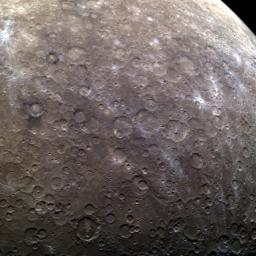
|
The Beauty of Calibration
- Click the image above for a larger view
- Full-Res JPEG (1017 x 1017) (195.8 kB)
- Full-Res TIFF (1017 x 1017) (3.1 MB)
Caption:
The set of images shown here in color was acquired as part of a sequence intended to monitor any changes in the calibration of the multispectral Wide Angle Camera over time, but it also gives a beautiful view of Mercury's cratered southern hemisphere. The craters Magritte , Neruda, and Sher-Gil can be spotted within this scene. North is to the top-left of the image.
Date acquired:
December 17, 2012
Image Mission Elapsed Time (MET):
264237810, 264237814, 264237830
Image ID:
3157538, 3157539, 3157543
Instrument:
Wide Angle Camera (WAC) of the Mercury Dual Imaging System (MDIS)
WAC filters:
9, 7, and 6 (996, 748, and 433 nanometers) in red, green, and blue
Center Latitude:
-59.16°
Center Longitude:
149.3° E
Resolution:
1,663 meters/pixel
Scale:
This scene is over 1,900 km (1,180 mi.) across
Incidence Angle:
59.2°
Emission Angle:
28.8°
Phase Angle:
78.1°
Background Info:
The MESSENGER spacecraft is the first ever to orbit the planet Mercury, and the spacecraft's seven scientific instruments and radio science investigation are unraveling the history and evolution of the Solar System's innermost planet. Visit the Why Mercury? section of this website to learn more about the key science questions that the MESSENGER mission is addressing. During the one-year primary mission, MDIS acquired 88,746 images and extensive other data sets. MESSENGER is now in a year-long extended mission, during which plans call for the acquisition of more than 80,000 additional images to support MESSENGER's science goals.
For information regarding the use of images, see the MESSENGER image use policy .
Cataloging Keywords:
| Name | Value | Additional Values |
|---|---|---|
| Target | Mercury | |
| System | ||
| Target Type | Planet | |
| Mission | MESSENGER | |
| Instrument Host | MESSENGER | |
| Host Type | Orbiter | |
| Instrument | Mercury Dual Imaging System (MDIS) | |
| Detector | Wide Angle Camera (WAC) | |
| Extra Keywords | Color, Crater, Radio | |
| Acquisition Date | ||
| Release Date | 2013-02-08 | |
| Date in Caption | 2012-12-17 | |
| Image Credit | NASA/Johns Hopkins University Applied Physics Laboratory/Carnegie Institution of Washington | |
| Source | photojournal.jpl.nasa.gov/catalog/PIA16820 | |
| Identifier | PIA16820 | |
